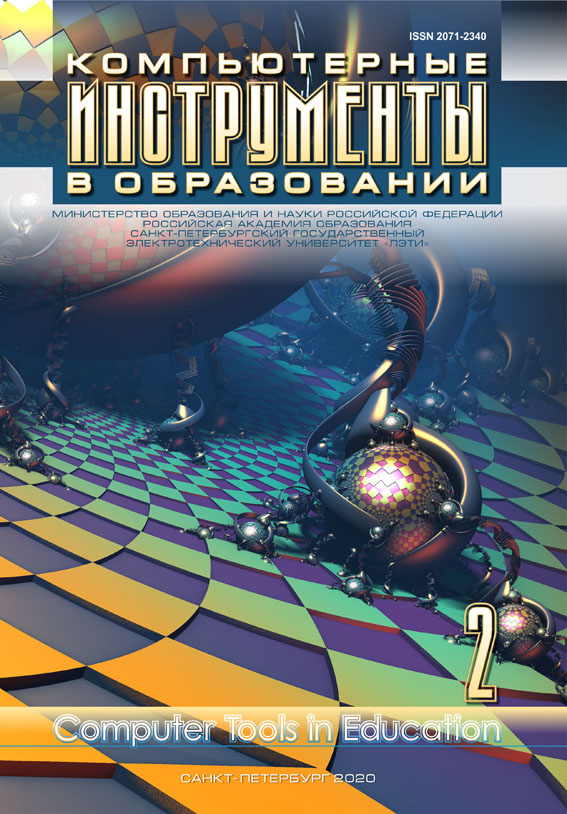Understanding the Problem by Modeling the Subject Area (with the Goal of Creating a Task Generator)
Abstract
This article presents a theoretical analysis of the problem of comprehending educational material in mathematics on the example of a problem that was proposed by NN Pangina as a “touchstone” for studying the interaction of a teacher and a student in organizing the latter’s independent work (from ed.: Pangina’s article is published in this issue of the journal).
The article discusses a methodological approach based on changing the pedagogical goal in relation to the task. Instead of starting with a search for a solution to the problem with specific data and focusing the student’s attention on “building a route” from the conditions of the problem to what needs to be found, it is proposed to build models that allow generating new problems similar to the one given.
This formulation of the problem changes the psychological attitude of the student, relieves him of responsibility for the success of solving a specific problem. At the same time, prompted pushed by the teacher, the student builds various simulation models that can be easily programmed and turned into problem generators, thereby forming a mathematical model of the problem area in which the problem was set.
The proposed approach is based on the activity approach proposed in the works of AN Leontiev in the 70s of the last century [1], the idea of bringing out difficult-to-understand intellectual actions outside in order to use the mechanism of internalization [1, 2] and the works of Simour Papert related to the use of computer artifacts as intermediaries for comprehending new mathematical ideas [3, 4].
References
A. N. Leont’ev, Deyatel’nost’. Soznanie. Lichnost’ [Activity, Consciousness, and Personality], vol. 2, Moscow: Pedagogika, 1983 (in Russian).
L. S. Vygotskii, Psikhologiya razvitiya cheloveka [Human Development Psychology], Moscow: Smysl, Eksmo, 2005 (in Russian).
S. Peipert, Perevorot v soznanii. Deti, komp’yutery i plodotvornye idei [Mindstorms: Children, Computers, and Powerful Ideas], Moscow: Pedagogika, 1989 (in Russian).
S. Papert, “An Exploration in the Space of Mathematics Educations,” Int J Comput Math Learning, vol. 1, no. 1, pp. 95–123, 1996; doi: 10.1007/BF00191473
A. Schoenfeld, Mathematical Problem Solving, New York: Academic Press, 1985.
U. J. Wilensky, Connected Mathematics — Building Concrete Relationships with Mathematical Knowledge, PhD diss., Massachusetts Institute of Technology, Cambridge, MA, US, 1993.
A. S. Prangishvili, Issledovaniya po psikhologii ustanovki[Research in Attitude Psychology], Tbilisi, Georgia: Izd-vo Metsniereba, 1967 (in Russian).
A. G. Asmolov, “On the hierarchical structure of the installation as a mechanism for regulating activity,” in The unconscious and its nature, functions and research methods, F. V. Basin, A. S. Prangishvili, and A. E. Sherozia, eds., Tbilisi, Georgia, vol. 1, pp. 147–157, 1978 (in Russian).
A. G. Asmolov, “O meste ustanovki v strukture deyatel’nosti” [On the place of installation in the structure of activity], PhD diss. in Psychology [Abstracts], Moscow State University, Moscow, 1976 (in Russian).
S. G. Ivanov and S. N. Pozdnyakov, “Komp’yuter v produktivnom obuchenii matematike ili kak informatsionnye tekhnologii mogut podderzhat’ intellektual’nuyu svobodu obuchaemogo” [Computer in productive teaching of mathematics or how information technologies can support the intellectual freedom of the student], Computer tools in education, no. 5, pp. 10–20, 2003 (in Russian).
S. G. Ivanov “Sochetanie diskussii s eksperimentom na uroke matematiki” [Combining discussion with experiment in a mathematics lesson], Computer tools in school, no. 2, pp. 66–72, 2009 (in Russian).
N. Vavilov, “Reshaping the metaphor of proof,” Phil. Trans. R. Soc. A, vol. 377, no. 2140, 2019; doi: 10.1098/rsta.2018.0279
M. Minsky, “Emotions and the Society of Mind,” M. Clynes and J. Panksepp, eds., Emotions and sychopathology, Springer, pp. 171–179, 1988; doi: 10.1007/978-1-4757-1987-1_7
V. V. Davydov, Problemy razvivayushchego obucheniya[Developmental learning problems], Moscow: Academia, 2004 (in Russian).
G. Polya, Mathematical discovery, Moscow: Nauka, 1970 (in Russian).
G. Polya, How to Solve It, Moscow: Librokom, 2010 (in Russian).
L. B. Gorelik, “Interactive mini-taskers,” Computer tools in school, no. 6, pp. 3–14, 2008 (in Russian).
M. I. Bashmakov, Teoriya i praktika produktivnogo obucheniya [Theory and practice of productive learning], Moscow: Narodnoe obrazovanie, 2000 (in Russian).
M. Wertheimer, Produktivnoe myshlenie [Productive thinking], Moscow: Progress, 1987 (in Russian).
S. F. Adlaj and S. N. Pozdnyakov, “Digital Representations of Mathematical Objects in the Context of Various Forms of Representation of Mathematical Knowledge,” Computer tools in education, no. 1, pp. 58–86, 2020 (in Russian); doi: 10.32603/2071-2340-2020-1-58–86
R. Noss and C. Hoyles, Windows on mathematical meanings: Learning cultures and computers, vol. 17, Springer Science & Business Media, 1996; doi: 10.1007/978-94-009-1696-8

This work is licensed under a Creative Commons Attribution 4.0 International License.







